- About us
- Support the Gallery
- Venue hire
- Publications
- Research library
- Organisation chart
- Employment
- Contact us
- Make a booking
- Onsite programs
- Online programs
- School visit information
- Learning resources
- Little Darlings
- Professional learning
Emily Kame Kngwarreye (c. 1910–1996) is one of Australia's most significant artists. An Anmatyerre woman, Kngwarreye was born at Alhalkere, Utopia Station in the Northern Territory. As she grew older she became a leader in Awelye (women's business), experienced in ceremonial body painting. In 1977 she was a founding member of the Utopia Women's Batik Group. Kngwarreye began to paint on canvas late in life, in 1988. During her brief career she produced thousands of canvases depicting the flowers, roots, dust and summer rains of her Country, the translucent colours built up with layered touches of paint to create an illusion of depth and movement. In 1998 a retrospective exhibition of Kngwarreye's work travelled around Australia, and ten years later Utopia: The Genius of Emily Kame Kngwarreye showed in Japan. With that exhibition, Kngwarreye was recognised as one of the very greatest abstract artists of the twentieth century.
For more than twenty years, Jenny Sages went on annual expeditions to Central Australia. On one of these trips Sages arranged to meet Kngwarreye. The two women sat on the dusty ground talking while Sages sketched, capturing the changing expressions on the Anmatyerre woman's face. Back in her Sydney studio, Sages developed this huge, spare painting, portraying Kngwarreye sitting cross-legged in the quintessential Australian landscape of her Country.
Purchased 1998
© Jenny Sages
The portrait is of Anmatyerre woman, Emily Kame Kngwarreye, one of Australia’s most significant contemporary artists, with her friend Lily. The painting was made by Jenny Sages in 1993, oil on canvas, and measures 2.16m tall by 1.85m wide, including its frame. The frame itself is discrete and simple, made from blond wood, and measuring about 2cm thick.
The portrait depicts Emily, close up, sitting cross legged, grounded on the earth, in the right foreground, and Lily, also sitting, some distance behind Emily, about half way up, and on the left edge of the picture. The focus and detail is on Emily, while Lily and the background landscape are less distinct. The warm orange-browns, yellows and whites, painted in loose, delicate brush strokes, shimmer and shine, capturing the heat of the day.
The background of the painting is flat and sparse, with no defined horizon, only a gentle gradient from lighter tones smudging together at the top, to darker shades in more defined strokes nearer the bottom.
Lily is shown at the very far left edge of the painting, her right side partially cropped. Her hair is a tangled mass of dark curls framing her round, dark skinned, face. Her face is angled slightly up to her left, as if she is turning towards Emily. Lily’s eyes seem to be on her friend and a smile plays over her closed lips. Lily wears a t-shirt, coloured in deep green-browns, with dashes of yellow where the light hits it. Her arms are loose with her hands resting, fingers just touching, in her lap. Lily is wearing a blue-green skirt and her bare legs are crossed.
On the ground between Lily and Emily is a pale grey-blue mass of lines which looks like the ashes of a small fire.
The portrait of Emily dominates the painting. Emily faces you directly, her head positioned straight on. Around her head, the brush strokes change from following the horizontal direction of the land in the background of the painting, to following the oval shape of her face, forming a sort of halo in whites and pale yellows. Emily’s white hair is cropped close to her skull, and her dark skin can be seen through it. Her forehead is high and elaborately furrowed – the furrows having their nexus at, and are most prominent where her brows, eyes, and nose meet. Emily’s eyes are dark crevices, the irises barely visible, surrounded by wrinkled skin. Her nose is large and smooth, with wide nostrils, and her ears are long and lie flat against her head. Emily’s cheeks are bunched up and deep lines run beneath them, between her nose and mouth. Emily’s lips are closed, with the lower slightly fuller than the upper - they are difficult to read, perhaps the glimmer of a smile is passing over them, or they may be set in resignation. Beneath the lips she has a small round chin, around this, her skin is loose and falls into the shadows of her creased neck.
Wound about Emily’s neck and tied loosely at her front, is a scarf, painted in fine brush strokes of pale yellows, orange-ochres and greens. Her top too, is made from many colours, - haphazard strokes in orange and yellow are layered and criss-cross each other in rich texture over her broad, rounded, and relaxed shoulders. These warm colours give over to lilac, mint-green, and black brush strokes, weaving together, and defining the volume and contours of her chest.
Emily’s elbows rest comfortably on the thighs of her crossed legs. Her bare forearms are covered in thick veins, her large, wrinkled hands come together at her shins, the left sitting lightly, partially over the right. Light falls on the hands, highlighting their creased skin, emphasising them. Emily’s skirt covers her crossed legs, and is white, with patches of bright orange-red and the suggestion of a floral pattern in greens and browns. Part of her left foot, in a white shoe, pokes out from under her right knee.
Audio description written by Lucie Shawcross and voiced by Emma Bedford



On one level The Companion talks about the most famous and frontline Australians, but on another it tells us about ourselves.
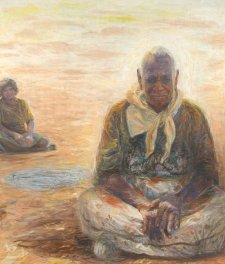
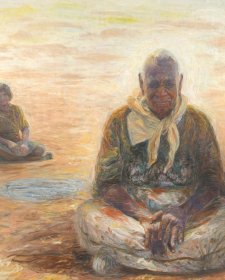
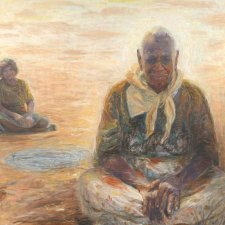
Joanna Gilmour reflects on 25 years of collecting at the National Portrait Gallery.
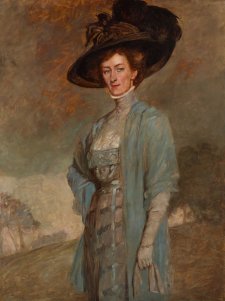
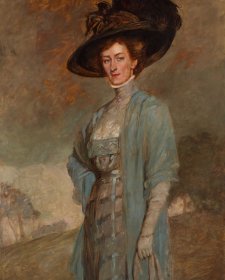
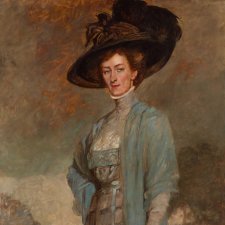
Jennifer Higgie uncovers the intriguing stories behind portraits of women by women in the National Portrait Gallery’s collection.